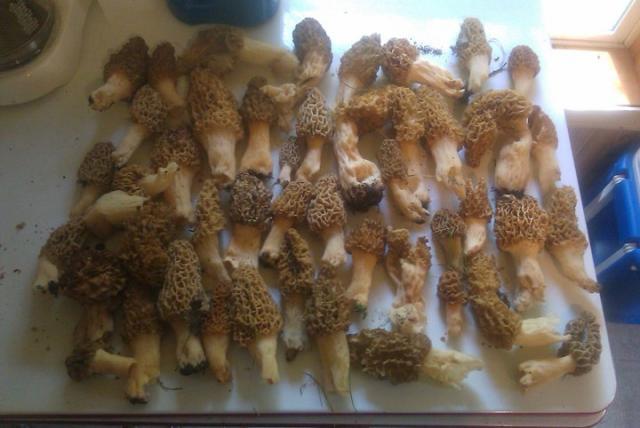I love wild mushrooms, we used to go on long hikes to hunt and harvest them. My favorite field guide is a book called All That the Rain Promises and More. Great photos, and it's the easiest to follow guide I ever found. Somebody stole my copy, (GRRRR!) but I keep planning to get a new one, and forgetting to order one when I have the money.
The best way I found to go about it is to learn the most common edible varieties in your area, especially the ones that are hard to mistake for a poisonous variety, and concentrate on those, rather than try to learn them all. The easiest to ID are chantrelles, boletes, morels, inky caps & shaggy manes (DO NOT consume alcohol within 24 hours before or after eating any variety of coprinus (sp?) such as the inkies or shaggies), oyster, puffballs, and some kinds of shelf fungus, like hen-of-the-woods, and sulfur shelf. Learn the poisonous kinds that may be mistaken for your target species, as well, and make sure you know what you have before you eat it. This is one case when you would be wise to follow the old adage, "If in doubt, throw it out."
I have found that the ones that are generally shown as poisonous look-alikes, don't really look all that much like the edibles, there are pretty obvious tell-tale traits to look for. If a person isn't observant enough to see those signs, they should probably not hunt wild mushrooms, and choose some other, less hazardous pastime. You'll have to decide if you can be a safe 'shroom hunter, or not. Learning to make spore prints is very helpful in identifying a species. It's not hard to do, and any good mushroom guide will show you how.
I would not venture an opinion as to edibility of those you posted, other than the white jelly fungus. Those are not generally poisonous, but not really food, either. Insipid, and an icky texture. The little round ones with no stem to speak of are a type of puffball, but I can't tell from the pic if they're for sure food or not. There's a poisonous variety called an earthball, and the edible ones have to be harvested and eaten during a pretty narrow window when they are food, they quickly become "no longer food". I've seen the pretty little yellow warty ones before, i don't remember what they are, though. They might be a type of amanita, a group that has both edible and poisonous varieties. The red ones with white spots are amanita muscaria, also calledfly agaric. http://www.art.com/products/p130613...ff=conf&ctid=983556896&rfid=504682&tkid=0&
The best way I found to go about it is to learn the most common edible varieties in your area, especially the ones that are hard to mistake for a poisonous variety, and concentrate on those, rather than try to learn them all. The easiest to ID are chantrelles, boletes, morels, inky caps & shaggy manes (DO NOT consume alcohol within 24 hours before or after eating any variety of coprinus (sp?) such as the inkies or shaggies), oyster, puffballs, and some kinds of shelf fungus, like hen-of-the-woods, and sulfur shelf. Learn the poisonous kinds that may be mistaken for your target species, as well, and make sure you know what you have before you eat it. This is one case when you would be wise to follow the old adage, "If in doubt, throw it out."
I have found that the ones that are generally shown as poisonous look-alikes, don't really look all that much like the edibles, there are pretty obvious tell-tale traits to look for. If a person isn't observant enough to see those signs, they should probably not hunt wild mushrooms, and choose some other, less hazardous pastime. You'll have to decide if you can be a safe 'shroom hunter, or not. Learning to make spore prints is very helpful in identifying a species. It's not hard to do, and any good mushroom guide will show you how.
I would not venture an opinion as to edibility of those you posted, other than the white jelly fungus. Those are not generally poisonous, but not really food, either. Insipid, and an icky texture. The little round ones with no stem to speak of are a type of puffball, but I can't tell from the pic if they're for sure food or not. There's a poisonous variety called an earthball, and the edible ones have to be harvested and eaten during a pretty narrow window when they are food, they quickly become "no longer food". I've seen the pretty little yellow warty ones before, i don't remember what they are, though. They might be a type of amanita, a group that has both edible and poisonous varieties. The red ones with white spots are amanita muscaria, also calledfly agaric. http://www.art.com/products/p130613...ff=conf&ctid=983556896&rfid=504682&tkid=0&
Last edited:













